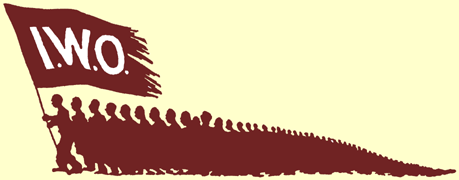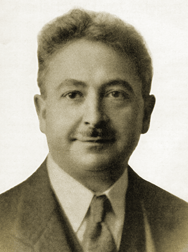
The International Workers Order began with a split of the Workmen's Circle, a Jewish mutual benefit society of social democratic coloration. Principle functions of the organization included the provision of unemployment, sickness, and life insurance and a setting for the discussion of social problems. This was byproduct of the Third Period ideology of the Communist movement, summed up by the slogan "Class Against Class" -- in which parallel organizations of revolutionary purity was sought as a general principle. It was, however, the end of a long and frustrating effort at winning the Workmen's Circle to a new line through the process of internal politics -- an effort which was thwarted at every turn by the Right majority of the organization.
There was long a Left Wing inside the Workmen's Circle organization. The 1920 Newark Convention of the Workmen's Circle stated that the organization was a working class fraternal organization but had decided to contribute thousands of dollars to organizations and newspapers deemed "reactionary" by the segment of Communist-oriented members within the group.
The Feb. 1922 nominating conference at which a new National Executive Committee was to be nominated brought to Left Wing to formal existence. Nearly 200 delegates attended this conference, which was dominated by the Socialists, who prevented a single representative of the Left on the Credentials Committee. A spontaneous walkout of Left Wing delegates resulted.
In May 1922 the Workmen's Circle held its 22nd Convention at Toronto. This convention was attended by 26 Left Wing delegates out of a total of 138, who battled over two resolutions of the Executive Committee: one against the Soviet Union for its judicial action against the Socialist Revolutionaries and other political opponents and a second against the Workers Party of America and its Yiddish language organ, the Freiheit.
A "Protest Convention" was held on June 2, 1922, in response to the resolutions of the 22nd Convention. This was attended by 338 delegates, representing 235 branches of the organization from 23 states. In addition to passing resoltuions, this Protest Convention elected a committee of 15 called the Left Action Committee. This committee included: D. Abrams, Abraham Epstein, Krantz, Kretchmar, Noah London, Lotker, Mindell, Oshinsky, Raskin, R. Salzman, David Siegel, Sultan, Wosk, and P. Yuditch,
On June 11, 1922, the National Executive Committee of the Workmen's Circle struck back, dissolving the Left Wing-dominated Boston District Committee. On July 2, 1922, Lotker was expelled from the New York Committee, and on July 22 the NEC transfered Left Wingers Linden and Rsnik from Pittsburgh to the status of "members at large." Similar treatment was meted to Reingold in Cleveland.
When elections to the National Board of Directors approached in 1922, the Left Wing found itself in a majority positiion in Minnnesota, Missouri, Virginia, Texas, and Ontario. The National Executive Committee therefore dissolved 5 state organizations and various Left Wing branches, and divided other branches favorable to its regime, thereby assuring itself of more votes. Despite these actions, the Left Wing resisted splitting the organization, continuint its fight within the Workman's Circle organization through 1925.
The 1925 Convention of the Workmen's Circle was attended by about 1,000 delegates, of whom approximated 1/4 supported a program of the Left Wing calling for the Workmen's Circle to become a class struggle organization and to stop its persecution of the Left Wing. The Left Wing fought for days to win the right to read its 10 minute declaration to the Convention. This declaration stated that "to our shame, the Workmen's Circle, our Order, lately has become and out-and-out toll and weapon in the hands of the reactionary element in the Jewish working class movement."
One of the Left Wing's chief projects within the Workmen's Circle revolved around the establishment of Jewish Workers' Children's Schools, akin to the Socialist Sunday Schools and intended as "an anti-toxin to the bourgeois poison daily injected into the children's minds in the public schools, the movies, and other places." The Right came to see these schools as a propaganda arm of the Left Wing movement and moved to attack them. On Dec. 20, 1925, a conference of Workmen's Circles branches on the schools was addressed by the Right, which called for an entirely new model for the schools, replacing local school organizations with administrations elected by centralized conventions. The December 1925 conference turned down this restructuring, which was answered by the calling of a second conference, this one more closely packed by the central leadership. This conference prompted a walkout of over 100 Left Wing participants, who vowed not to accept the restructuring. As a result, 18 out of 24 schools in New York City were expelled from the Workmen's Circle. These expelled schools came together as the "Non-partisan Jewish Workers' Children's Schoolls" -- an organization which grew to encompass 83 schools by the time of their affiliation with the International Workers Order.
A "National Protest Conference" was called in protest of the 1925 Convention. At total of 191 branches were represented at this gathering, which was in session for two days. The conference organized itself into a "Left Wing Alliance" and declared that it would fight "against the terror of the Right Wing machine" and "for the non-party [i.e. non-Socialist Party] character of teh Workmen's Circle." Aid to the childrens' school movement was pledged.
The National Executive Committee of the Workmen's Circle responded to the organization of the Left Wing Alliance predictably, expelling 64 branches with a membership of close to 15,000. This put the Executive Committee of the Alliance in a difficult situation. Rather than the "suicide" of a premature split, the Executive Committee instructed its branches to comply with various requests of the NEC to resign from the Alliance or be expelled. A split was averted by the Alliance backing down and peace movement resulted, with pressure was placed on the NEC. To this end, a Special Conference was called by the Providence, RI City and District Committee on Oct. 30, 1926, whereby branches would withdraw from the Alliance en masse and be reinstated as branches of the Workmen's Circle. This gathering was attended by representatives of 188 branches. However, the NEC of the Workmen's Circle did not even attend the gathering. Rather than instantly reinstating branches, as promised, the NEC instituted a lengthy process for reinstatement drawing out the process over months and even years, so as to demoralize the Left Wing.
The 1929 Convention of the Workmen's Circle attempted to eliminate the Left Wing from participation. The gathering was addressed by a guest speaker, Victor Chernov, leader of the Right faction of the Russian Socialist-Revolutionary Party. It was charged that a physical attack was made on the reporter of the Communist Party's Yiddish daily, the Freiheit. The convention renewed the two controversial Toronto resolutions of 1922 and formally approved the action of the NEC in suppressing the Left Wing movement in the Workmen's Circle.
3. National Conference of Minority Groups of the Workmen's Circle --- New York City --- Oct. 11-13, 1929.
The National Conference of Minority Groups of the Workmen's Circle was attended by 193 delegates, representing 108 branches and 23 minority factions of branches. These delegates unanimously decided to leave the Workmen's Circle and build a new explicitly working class order. A manifesto issued by the conference declared:
"The time has come when everyone who takes the interests of the workers seriously must shake offf the dust of the Workmen's Circle. The Workmen's Circle, originally organized under the banner of the class struggle, writing into its program the abolition of the capitalist order...has been transformed in the past few years into an instrument of capitalist politics.
"There was not one single important occasion in the life of the Jewish workers in the last 7 or 8 years when the leadership of the Workmen's Circle did not line up with the enemies of the working class. The counterrevolutionary physiognomy of the Workmen's Circle is most clearly expressed in its attitude toward the Soviet Union, the only proletarian state inthe world, the pride and crown of achievement of all class conscious workers throughout the entire world."
[fn. R. Saltzman, "First Struggles for Proletarian Order," in Five Years of the International Workers Order, 1930-1935. (NY: NEC of the IWO, 1935), pg. 14.]
The 1929 National Conference initially sought to join an already-existing "Independent Workmen's Circle" organization. While 7 of the 9 members of the National Executive Committee of the Independent Workmen's Circle were in favor of the Left Wing affiliating, the two remaining members, including the Acting Secretary, attempted to use doctors' examinations as a pretext for exclusion. The NEC majority attempted to depose the Acting Secretary in response, but the opponents of the Left Wing in the Independent Workmen's Circle took to the courts, winning an injunction to block the amalgamation. A court-supervised "Injunction Conference" was held on January 12, 1930, to formally decide the matter of the Left Wing's admission to "The Independent." This gathering defeated the motion by a vote of 48 to 45, however, thereby ending the plan of amalgamation.
Incorporation papers for the IWO were filed on March 28, 1930, which the organization recognized as its date of birth. About 5,000 Left Wing members of Workmen's Circles left to found this new organization.

The 1930 Conference called by the National Committee of Progressive Branches of the Workmen's Circle was attended by over 200 delegates, representing 157 branches of the Workmen's Circle and the Independent, as well as 13 minority groups from other branches. The conference approved the name
In the Summer of 1932, the Hungarian Workers' Educational and Benevolent Society merged through the decision of a convention of its membes and subsequent referendum. 4,000 members of that organization were thus established as the Hungarian Section of the IWO.
In the Summer of 1933, the Slovak Workers Society decided by vote of its members to afffiliate with the IWO, bringing in another 4,000 adult members. This became the Slovak Section of the IWO.
The 2nd Convention completed the amalgamation of the Hungarian and Slovak Sections of the IWO.
In 1933, the Russian National Mutual Aid Society affiliated with the IWO, the third outside national section of the organization.
At the beginning of July 1933, the Jewish Section of the International Workers Order was officially established. The Jewish section contained about 1/3 of the organization's membership plus an additional complement of The organization at that time also contained formal Hungarian, Slovak, Russian, English, Polish, Ukrainian, Romanian, and Italian sections.
DOWNLOADS
1931
MAY
At the time of the 3rd Convention of the IWO, the organization claimed "nearly 75,000 adult and child members," not including the appoximately 9,000 members of the Russian National Mutual Aid Society.

N. Airoff, Joseph Brodsky, L. Candela, M. Dzurik, K. Eisenberger, J. Feher, R. Fiedler, D. Greene, I. Gukowsky, H. Houlton, C. Korenic, R. Kubichek, S. Mensher, Gus Mayer, H. Poltkin, G. Primoff, A. Rosenbaum, S. Rosenthal, R. Saltzman, N. Shaffer, Peter Shipka, A. Spitzer, E. Stoklas, I. Sultan, M. Tkach, M. Tolciss, J. Trauber, William Weiner, M. Work.
xxxxx
sources: National Executive Committee of the International Workers Order, Five Years of the International Workers Order, 1930-1935. (NY: NEC of the IWO, 1935),